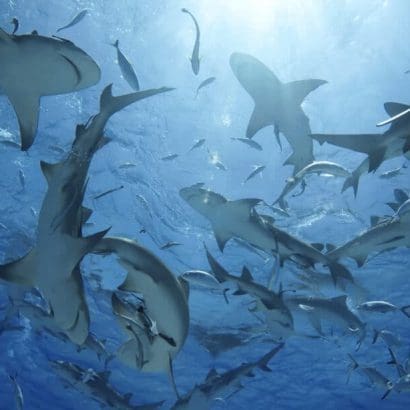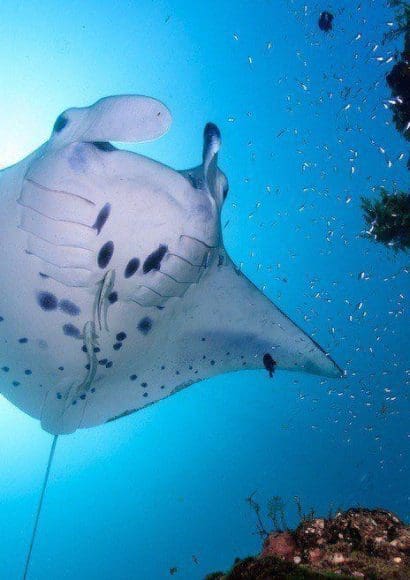
Manta rays, with their graceful and majestic presence, captivate the imagination of ocean enthusiasts and marine biologists alike. These fascinating creatures, known for their enormous size and distinctive appearance, have developed unique feeding strategies to sustain themselves in the vast oceanic realms. In this article, we will delve into the intriguing world of manta rays and explore how they acquire their sustenance in the ocean.
From their specialized anatomical adaptations to their feeding behaviors, we will unravel the secrets behind the feeding habits of these enigmatic creatures. Join us as we dive into the depths of the ocean to uncover the mysteries of how manta rays feed and thrive in their marine environment.
Contents
Characteristics of manta rays.
Manta rays are fascinating creatures that possess distinct features and adaptations that set them apart in the marine world. Here are some general characteristics of manta rays: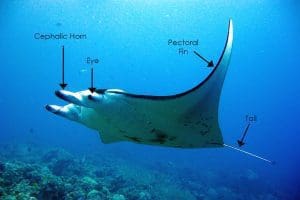
Size and Shape:
Manta rays are among the largest species of rays, with some individuals reaching widths of up to 7 meters (23 feet) or more. They have a flattened body structure that resembles a diamond or a giant flying carpet. This unique shape allows them to effortlessly glide through the water with remarkable grace.
Skin and Coloration:
The skin of manta rays is smooth and usually features a dark upper side and a lighter underside. This coloration pattern, known as countershading, helps camouflage them in their oceanic environment. Additionally, manta rays may have distinct patterns of spots or markings on their dorsal surface, which can be used to identify individuals.
Cephalic Fins:
One of the most recognizable features of manta rays is their prominent cephalic fins, also referred to as “horns” or “head fins.” These extensions on each side of their head are used to direct and channel water into their mouths while feeding.
Mouth and Gill Slits:
Manta rays possess a wide, gaping mouth located on the ventral side of their body. They have specialized structures called gill slits, located behind their eyes, which allow them to extract oxygen from the water as it passes through.
Dentition:
Unlike other species of rays, manta rays do not possess sharp teeth. Instead, they have specialized structures known as “gill rakers” or “raker plates” that line their gill arches. These raker plates aid in filtering out tiny organisms, such as plankton, from the water.
Vision:
Manta rays have large, forward-facing eyes positioned on the sides of their head, providing them with excellent binocular vision. This helps them navigate their surroundings, locate prey, and avoid potential threats.
Life Span:
Manta rays have a relatively long lifespan, with some individuals living up to 40 years or more. However, their exact lifespan can vary depending on factors such as species, environmental conditions, and predation risks.
Anatomy and adaptations for feeding.
The anatomy of manta rays is intricately designed to support their feeding habits and enable efficient consumption of their preferred diet. Here is some general information about the anatomy and adaptations of manta rays for feeding:
Gill Rakers and Filter Feeding:
Manta rays are filter feeders, relying on a specialized feeding technique to extract food from the water. Their gill arches are equipped with numerous long, slender structures called gill rakers. These gill rakers act as filters, capturing small prey items such as plankton, krill, and tiny fish as water passes through their gill slits. The captured prey is then directed towards the mouth for consumption.
Cephalic Fins and Feeding Behavior:
The prominent cephalic fins of manta rays play a crucial role in their feeding behavior. These fins, located at the front of their heads, are unfurled to form a funnel-like structure. By spreading open their cephalic fins, manta rays can channel large volumes of water into their mouths, effectively trapping their prey within.
Elongated Mouth and Ventral Positioning:
Manta rays have wide, elongated mouths that are positioned on the ventral side of their bodies. This positioning allows them to swim close to the water’s surface, skimming the upper layers where food sources such as plankton are abundant. The ventral mouth orientation facilitates the efficient capture of prey as they swim through concentrated areas of food.
Filtered Food Passage:
Once the manta rays have filtered out the desired prey items, the water is expelled through their gill slits. The gill rakers ensure that only the suitable-sized food particles pass through into the digestive system, while any excess water and debris are eliminated.
Efficient Digestive System:
Manta rays possess a well-developed digestive system that is capable of processing and extracting nutrients from the vast amounts of small prey they consume. Their digestive tract is optimized for efficiently breaking down and absorbing the nutritional content of their filter-fed diet.
Feeding strategy of manta rays.
Manta rays have evolved a unique feeding strategy that allows them to efficiently capture and consume their preferred food sources in the ocean. Here is some general information about the feeding strategy of manta rays:
Diet:
Manta rays are primarily filter feeders, relying on small organisms such as plankton, krill, small fish, and crustaceans as their main food sources. They have a specialized diet consisting of tiny prey items that are abundant in the water column.
Filter Feeding:
Manta rays employ a feeding technique called filter feeding to extract food particles from the water. As they swim, they open their wide mouths and expand their cephalic fins to create a funnel-like structure. This allows them to channel large volumes of water into their mouths, capturing the small organisms present in the water column.
Gill Rakers:
The gill arches of manta rays are lined with numerous gill rakers, which are long, slender structures that act as filters. These gill rakers trap the small prey items, such as plankton, while allowing the water to pass through their gill slits. The captured food particles are then directed toward the mouth for ingestion.
Surface Feeding:
Manta rays often feed near the water’s surface, where plankton and other small organisms tend to concentrate. They swim with their mouths open, filtering the upper layers of water for food. This surface feeding behavior allows them to exploit the abundance of food resources in these areas.
Filtered Food Consumption:
After filtering out the prey, manta rays close their mouths and swallow the captured food items. The gill rakers ensure that only suitable-sized particles pass through into the digestive system, while excess water and debris are expelled through the gill slits.
Feeding Aggregations:
Manta rays sometimes gather in feeding aggregations, where groups of individuals congregate in areas with high concentrations of food. This behavior allows them to take advantage of the abundant prey resources and maximize their feeding efficiency.
Hunting behavior.
Manta rays exhibit fascinating hunting behaviors as they navigate the ocean in search of prey. Here is some general information about the hunting behavior of manta rays: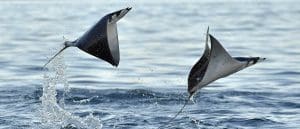
Search and Scanning:
Manta rays employ a combination of visual and sensory cues to locate potential food sources. They swim in a deliberate and methodical manner, scanning the water column for signs of prey, such as aggregations of plankton or the movement of small fish.
Feeding Aggregations:
Manta rays are known to gather in feeding aggregations, where multiple individuals come together to exploit concentrated food sources. These aggregations can form in areas where there is an abundance of plankton or during certain times of the year when prey populations are higher.
Swirling and Spiraling:
When manta rays detect a dense concentration of prey, they may exhibit swirling or spiraling behavior. This involves swimming in circular patterns, often near the water’s surface, to create a vortex that corrals and concentrates the prey. By using this technique, manta rays can trap and engulf a larger amount of food in a more efficient manner.
Filter Feeding on the Move:
Manta rays are capable of filter feeding while in motion. They can swim with their mouths open, allowing water to flow over their gill rakers and capturing prey as they continue to swim forward. This continuous feeding strategy enables them to efficiently filter out food particles while on the move.
Vertical Feeding:
In certain situations, manta rays may display vertical feeding behavior. They swim vertically in the water column, rising or descending to target specific layers where their preferred prey is abundant. This vertical movement allows them to optimize their feeding efforts by targeting areas with the highest concentration of food.
Opportunistic Feeding:
While manta rays have a preferred diet of plankton and small organisms, they can also display opportunistic feeding behavior. This means that they may take advantage of other food sources available in their environment, such as small fish or crustaceans, when the opportunity arises.
Reproduction of manta rays.
The reproductive process of manta rays is a fascinating aspect of their life cycle. Here is some general information about the reproduction of these majestic creatures: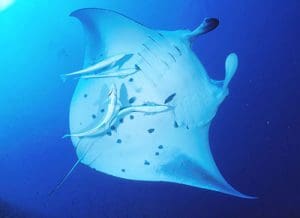
Sexual Dimorphism:
Manta rays exhibit sexual dimorphism, which means there are physical differences between males and females. Females tend to be larger than males, and they possess a wider wingspan and a more robust body structure.
Courtship and Mating:
The courtship and mating behaviors of manta rays are not well-documented, but it is believed that they engage in elaborate courtship rituals. Males may approach females and perform various displays to attract their attention and demonstrate their fitness as potential mates. These displays can involve swimming patterns, body movements, and possibly even vocalizations.
Internal Fertilization:
Manta rays practice internal fertilization. During mating, males transfer sperm into the reproductive tract of the female using specialized structures called claspers, which are modified pelvic fins. The sperm fertilizes the eggs internally, inside the female’s body.
Gestation Period:
The gestation period of manta rays varies depending on the species, but it is estimated to be around 12 to 13 months. During this time, the fertilized eggs develop inside the female’s uterus.
Live Birth:
Manta rays are ovoviviparous, which means that the embryos develop within the female’s body, and the young are born live. Once the gestation period is complete, the female gives birth to one or occasionally two fully formed pups, known as juveniles. The newborns emerge tail-first from the mother’s body.
Maternal Care:
After giving birth, female manta rays do not provide direct parental care to their offspring. The juveniles are relatively independent from the moment of birth and must fend for themselves.
Maturity and Reproductive Cycle:
Manta rays reach sexual maturity at different ages, depending on the species and individual factors. It is believed that females mature later than males. Once mature, manta rays can reproduce periodically, with females producing offspring in intervals of one to three years.
The importance of manta rays in the marine ecosystem.
In conclusion, manta rays play a significant role in the marine ecosystem. Their presence and feeding habits contribute to the balance and health of the oceanic food web. By filtering vast amounts of plankton and small organisms, manta rays help control the population sizes of these prey species, preventing unchecked growth that could disrupt the ecological equilibrium. In turn, the availability of abundant prey resources attracts other marine organisms, creating a ripple effect that supports the biodiversity and productivity of the ecosystem.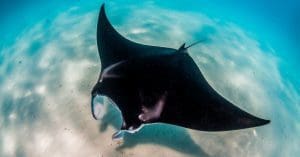
Furthermore, manta rays serve as indicators of ecosystem health. As they rely on specific prey populations and water conditions, any decline or alteration in their habitats can signal potential issues within the marine environment. Monitoring the well-being of manta ray populations can provide valuable insights into the overall state of the ecosystem and assist in conservation efforts.

